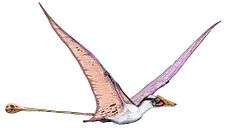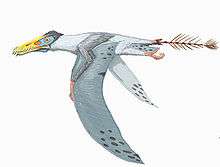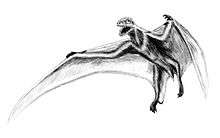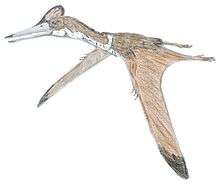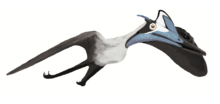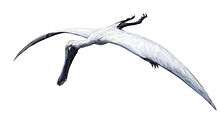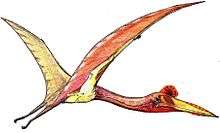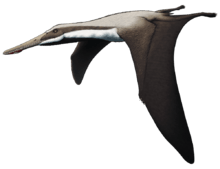Archaeoistiodactylus
Archaeoistiodactylus is an extinct genus of pterosaur from the Middle Jurassic of China.[1]
| Archaeoistiodactylus | |
|---|---|
| Scientific classification | |
| Kingdom: | Animalia |
| Phylum: | Chordata |
| Order: | †Pterosauria |
| Clade: | †Monofenestrata |
| Genus: | †Archaeoistiodactylus Lü & Fucha, 2010 |
| Type species | |
| †Archaeoistiodactylus linglongtaensis Lü & Fucha, 2010 | |
Discovery and naming
Archaeoistiodactylus is known from an incomplete skeleton with a partial skull and lower jaws. Catalogued as holotype specimen JPM04-0008, it was recovered from rocks of the Tiaojishan Formation in western Liaoning, China, which date to the Bathonian-Callovian stages of the Cretaceous period. Apart from the skull, it preserves ribs, parts of the wings, hindlimbs and the pelvis. The neck, tail and feet of the specimen are lacking.[1]
Archaeoistiodactylus was first named and described by Lü Junchang and Fucha Xiaohui in 2010. The type species is Archaeoistiodactylus linglongtaensis. The generic name is a combination of the Greek archaios, "ancient", with the name of the genus Istiodactylus, referring to Archaeoistiodactylus being presumed to have been an older close relative of the latter. The specific name refers to the provenance near Linglongta.[1]
Description
The front teeth in the upper jaw of Archaeoistiodactylus are angled backwards. In the hand, the metacarpal bones are short.[1]
Classification
Lü and Fucha assigned Archaeoistiodactylus to the clade Breviquartossa and considered it to be more closely related to the istiodactylids than to any other group of pterosaurs; however, they considered it to be more primitive than the Cretaceous istiodactylids and regarded it as an ancestor, rather than member of istiodactylid pterosaurs.[1] David Martill and Steve Etches in 2013 suggested that the holotype specimen might actually be a poorly preserved specimen of Darwinopterus.[2] In 2014, Corwin Sullivan and colleagues considered the "distinctive midline tooth in the tip of the rostrum" of the holotype specimen to be a probable valid diagnostic feature of A. linglongtaensis; however, the authors considered it more likely that Archaeoistiodactylus was a basal monofenestratan than an istiodactylid.[3]
See also
References
- Lü, J. & Fucha, X. (2010). "A new pterosaur (Pterosauria) from Middle Jurassic Tiaojishan Formation of western Liaoning, China". Global Geology. 13 (3/4): 113–118. doi:10.3969/j.issn.1673-9736.2010.03/04.01 (inactive 2020-01-22).
- Martill, D.M. & Etches, S. (2013). "A new monofenestratan pterosaur from the Kimmeridge Clay Formation (Upper Jurassic, Kimmeridgian) of Dorset, England". Acta Palaeontologica Polonica. 58 (2): 285–294. doi:10.4202/app.2011.0071.
- Sullivan, C.; Wang, Y.; Hone, D.W.E.; Wang, Y.; Xu, X. & Zhang, F. (2014). "The vertebrates of the Jurassic Daohugou Biota of northeastern China". Journal of Vertebrate Paleontology. 34 (2): 243–280. doi:10.1080/02724634.2013.787316.
| Wikispecies has information related to Archaeoistiodactylus |
